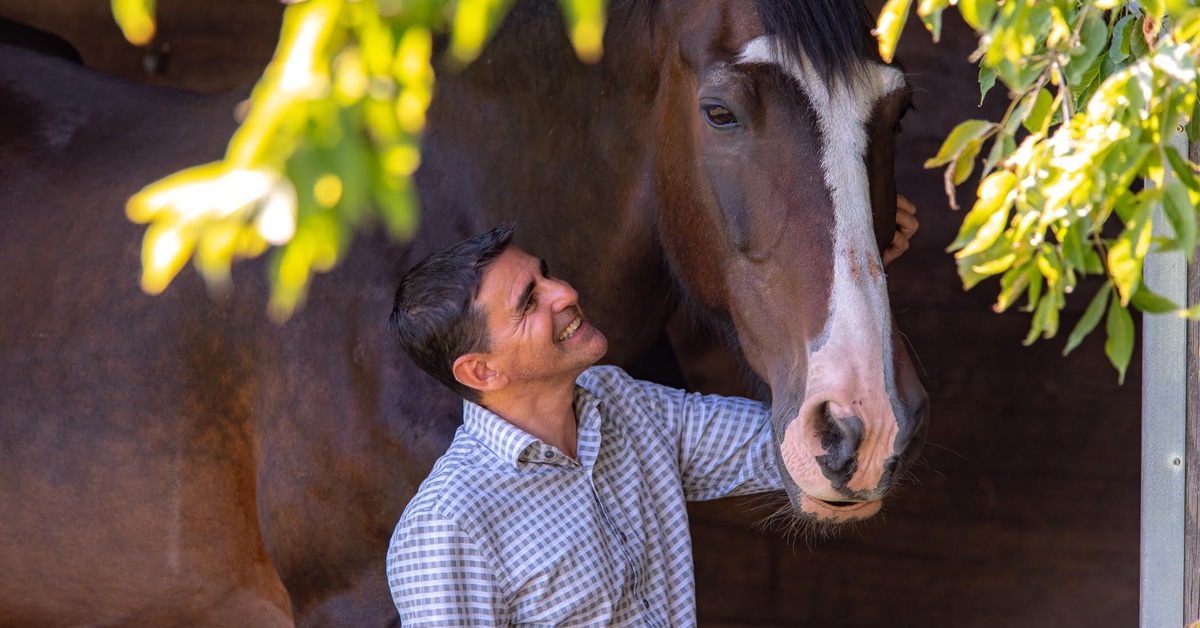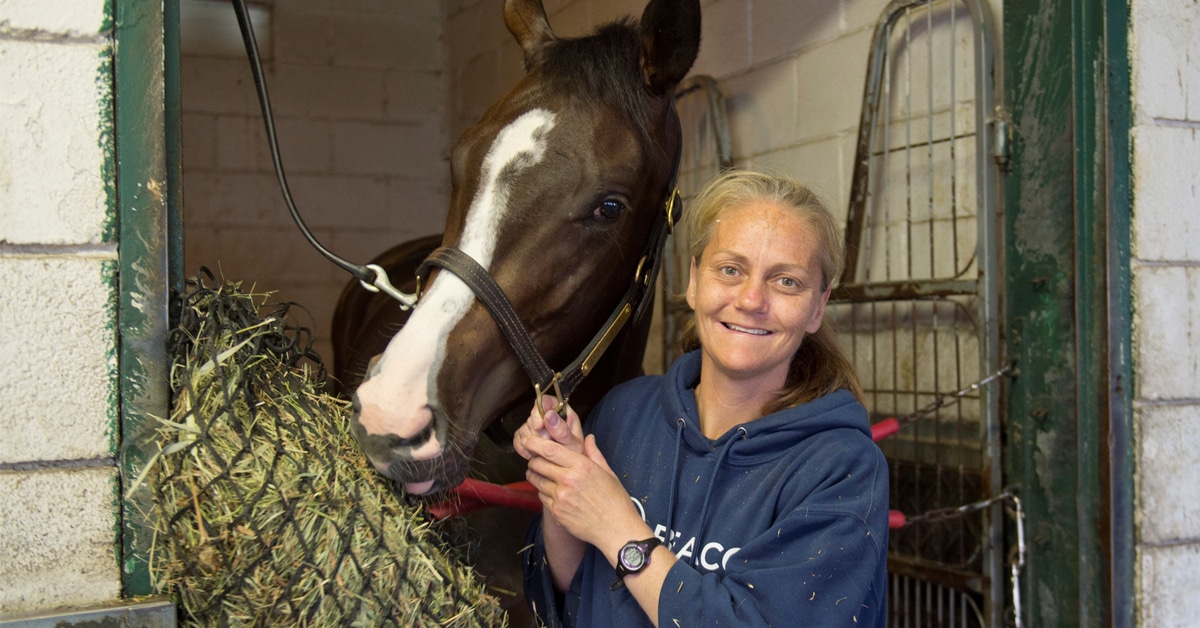While some trainers pass down recipes of success for generations, many horse owners realize that commercial feed companies stay on top of cutting edge nutritional research. Feed companies follow the research trends and develop products that are of interest to the health and performance of the horses, but also the needs and wants of the owners.
One of the biggest trends in the horse nutrition world is ‘low carb’ feeds. In fact, however, this is technically impractical (and even unsafe) for the horse, as fibre is a type of carbohydrate and is extremely important for the horse’s digestive health. More accurately, low starch and sugar, or low non-structural carbohydrate (NSC) feeds are desired by owners and their horses, for the management and/or prevention of several conditions including insulin resistance, polysaccharide storage myopathy (PSSM) and recurrent exertional rhabdomyolysis (RER) (read more on RER further on in this article).
Almost every horse feed company has some kind of low starch/high fat and fibre type of feed suited to these horses. In fact, the trend is moving beyond the traditional commercial concentrates, and we are seeing more and more low NSC hay and/or haylage being marketed. Unfortunately however, there are regulations in which the NSC values of feeds do not need to be reported on feed tags, nor is there a universal designation for a value of ‘low starch’ (i.e is it less than 15% NSC or less than 10% NSC?). And the question remains, is there some benefit to the hype? Diets low in starch and sugar are in fact beneficial to horses with some metabolic conditions such as insulin resistance, PSSM and RER, and may also help prevent the development of insulin resistance. That said, there are some horses that actually need higher amounts of starch and sugar in their diets, such as those in heavy work, and those needing to replenish glycogen stores rapidly following exercise (such as following thesecond day of a 3-day event).
Other trends in the feed industry include additives such as omega-3 fatty acids or probiotics, both of which may have some potential health benefits to the horse (though research findings are conflicting). We’re also seeing more ‘natural’ or ‘organic’ alternatives to our horse feed, which may satisfy the needs of some owners.
It is always interesting to look through the feed selection at a small animal veterinary clinic. There are so many specialized feeds, formulated for everything from bladder conditions, diabetes, joint or skin health to hypoallergenic formulas. Some horse feed companies are also developing similar products, designed specially for unique equine conditions. It wouldn’t be a surprise if this trend continues and expands to provide specialized feeds for horses with, for example arthritis or gastric ulcers. Research is ongoing at many universities to help better determine the nutritional needs of horses and to devise diets to improve their health and performance. With the support of the horse owners and the feed companies, new trends may be coming soon to a feed mill near you!
Research Advances in Recurrent Exertional Rhabdomyolysis (Tying Up)
Tying up in racehorses is not new but there have been advances in the studies on what causes it and how to treat it
by Shannon Pratt-Phillips, PhD.
Recurrent exertional rhabdomyolysis (RER) is a condition that affects athletic horses, and is also known as tying up or azoturia. It is relatively common in thoroughbred and standardbred racehorses, and has the potential to affect the horse’s performance capabilities. Although ‘tying up’ has been reported among trainers for generations, only within the past 10 years has extensive research been conducted into the genetic causes and nutritional management of the disease.
Tying up refers to a condition in which the horse exhibits severe muscle cramping and pain, along with a reluctance to move or exercise. It is also called azoturia, due to common reddish-brown urine exhibited by the horses, which is caused by the breakdown of muscle proteins. Some of these proteins (in particular creatine kinase, CK, and aspartate aminotransferase, AST) are also elevated in and may be used to confirm tying up. These symptoms, however, are not unique, and are also often observed in another exercise-related muscle condition, polysaccharide storage myopathy (PSSM). It wasn’t until these two conditions were identified as being distinct by Dr. Stephanie Valberg at the University of Minnesota (in 1999), that research into RER escalated.
RER is a result of a defect in calcium regulation within the muscle cell, causing the muscle cell to be hypersensitive to stimulation. In contrast, PSSM is a condition where muscle glycogen (the storage form of glucose within the body) is not formed properly. Further, RER tends to be more common in thoroughbreds and standardbreds, while PSSM is more common in Quarter horses.
The incidence of RER in horses ranges between about 5-7% of thoroughbreds and standardbreds. Specifically, about 4.9% American thoroughbreds have been diagnosed with RER, while 6.7% of thoroughbreds from the UK and Standardbred trotters in Sweden have an incidence rate of 6%. The incidence of RER in Canadian thoroughbreds has not been reported.
Research has also shown that RER is most common in fillies, with females being 4.3 times more likely to exhibit RER. Horses with a nervous temperament are 5.5 times more likely to have RER than horses with more of a calm temperament. In addition, horses between two and three-years of age tend to be most commonly affected.
The prevalence of this disorder, along with its frequency in females suggests that the disease is autosomal dominant disorder, and may be sex-linked. Research is being conducted to isolate a specific gene or sets of genes within the genome that result in the altered calcium regulation. Research is also being conducted on the expression of micro RNA, which are regulators of gene expression and may affect muscle development. Several microRNA molecules appear to be more highly expressed in horses with RER than in controls. Researchers are also investigating the use of biomarkers (such as unique proteins) in muscle or blood that may be able to help diagnose the condition. Further, any different or unique protein may help elucidate the cause of the disease, which may lend way to a treatment.
Numerous studies have also been conducted on nutritional management of RER. The incidence of RER appears to be higher when horses are fed large amounts of grain, therefore researchers have investigated the effects of different types of diets on horses with and without RER. Diets that are lower in starch and sugar, and higher in fat and fiber (but have the same amount of calories) tend to result in horses having lower amounts of CK in their blood after exercise. The effect of diet may be related to behavior, as horses consuming diets higher in starch and sugar (more accurately non-structural carbohydrates, or NSC) appear to have higher resting heart rates.
Further, fit horses had higher insulin and cortisol concentrations following the consumption of a high starch and sugar meal, than either unfit horses, or those fed a higher fat diet; suggesting a potential link between fitness, behavior and excitability, with diet. Current recommendations are for horses susceptible to tying up receive no more than 20% of their daily energy intake as NSC. Furthermore, it has been suggested that horses with RER may benefit from supplemental vitamin E and selenium, which may reduce muscle damage.
While recurrent exertional rhabdomyolysis is not a new condition, research in the past 10 years has increased to help answer many questions about it. With technological advances, research into genomics and heritability of the disease aim to pinpoint the causes and mechanism of recurrent exertional rhabdomyolysis. From there, better treatments may be developed.
The Latest










